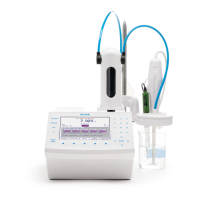4.3.2.2. DISPENSING ERRORS
Incorrect dispensing due to:
• Dead valve volume and leaking valve
• Inaccuracy in motor drive and gear lash/ backlash
• Poor burette/ piston seal
• Non-uniform diameter of burette glass cylinder
• Chemical incompatibility with tubing or bubble generation
• Density/ temperature changes in titrant
4.3.3. CHEMICAL REACTION ERRORS
• Inappropriate solvent or sample resulting in side reactions
• Poor mixing of the titrant and solvent or sample in the titration vessel
• Reaction between titrant and sample is not rapid
• Reaction does not go to completion
• Reaction has side reactions
4.3.4. ENDPOINT DETERMINATION ERRORS
Most manual titrations use a visual indicator to indicate when the endpoint is reached and the titration should be stopped. Automatic
titrators use instrumental methods to determine the end of a titration and the equivalence point. There are two predominant methods
used to determine the equivalence point, first derivative and second derivative.
The inflection point of the titration curve (mV vs. Volume) is normally assumed to be the equivalence point. The first derivative is
often used to determine the inflection point. The maximum value of the first derivative (dmV vs. dV) corresponds to the theoretical
equivalence point. During a titration it is rare to have a data point exactly at the first derivative maximum, the maximum value is
determined by interpolating the first derivative data points.
The second derivative (d
2
mV vs. dV
2
) can also be used to determine the equivalence point, and can offer advantages over the first
derivative method. Second derivatives have increased sensitivity to smaller inflection points and easier numerical evaluation of the
actual equivalence point. The value where the second derivative is equal to zero is the equivalence point. The second derivative
requires fewer points located near the equivalence point, where data is often not obtained or not as reliable.
Errors in determining the endpoint can result from:
• Incorrect signals from the sensor
• Sensor drift
• Sensor or instrument has slow response, keep sensors in good condition
• Inappropriate setting on the titrator

